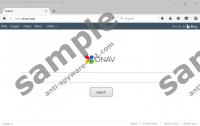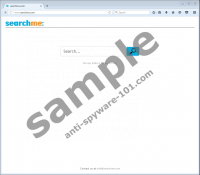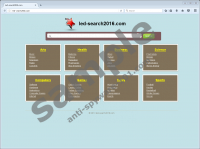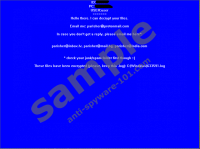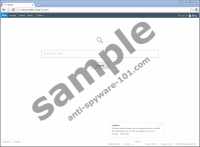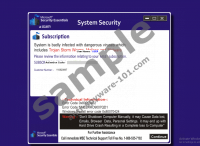Dnav.com looks like a search engine, and it provides search results; however, it does that by redirecting you to Bing.com search engine, and that is quite strange. Did you know that you would be redirected to Bing when using this search tool? The information representing this search tool informs that it uses Google, Yahoo, and Bing services to provide users with search results. On top of that, the interface includes a tag that says “Results by Bing,” which, of course, should make it clear that this suspicious search provider does not produce its own results. Here is a question for you: Why do you need a search tool like that? Would it not be more convenient just to employ Bing as your default search provider or to open on startup? The reality is that the search results shown to you are meant to distract you from something else, and that is what we discuss in this report. We also discuss the best way to delete Dnav.com from your web browsers. Read more »
Searchme.com
According to our researchers, Searchme.com is a browser hijacker that also doubles as a search engine that is distributed in a malicious manner. Thus, you might want to remove it from your PC entirely. Researchers have also found that its search results are also likely to contain promotional links because it comes from a developer that is in the online advertising business. Indeed, there is nothing unique or useful about this hijacker, and it will not improve your browsing experience in any shape or form. In fact, it will only hinder it and put your PC at risk as it promotes content from unknown entities. Read more »
Trickbot Virus
Anti-Spyware-101.com research team warns about a new threat, Trickbot Virus. This is a banking Trojan that is likely to have been created by the same people who stood behind the already dismantled Dyre Trojan, also known as Dyreza Trojan. The loaders of both of these infections are practically identical, and they serve the same purpose. The differences between these infections are in the programming language (the new version was created using C++, and Dyre was created using C language) and programming interfaces (the new version uses Microsoft CryptoAPI). Other than that, both Trojans are very similar, which is why it is believed that they were developed by the same group of cyber criminals. As mentioned already, the new version of the infection is identified as a banking Trojan and, needless to say, it targets online banking accounts. Although, at the moment, this infection is localized in Australia, we do not dismiss the possibility that it will cross-over at some point in the future. Regardless of where you live, check if you need to remove Trickbot Virus, and implement security software to ensure protection against this malware. Read more »
Search.internetspeedpilot.com
Search.internetspeedpilot.com is a mere browser hijacker that was recently released by our old foe SaferBrowser. You should remove it in the event it hijackers your homepage and changes your browser’s homepage and new tab page address. Be warned that, if it does, then it will subject you to unreliable search results bound to feature shady and even malicious promotional links that could jeopardize your PC’s security and your personal privacy. Also, it should collect some non-personally identifiable information and use it for marketing and advertising purposes. Nothing good can come from this so-called search engine. Therefore, we invite you to find out more about it and read this whole article. Read more »
search2016-ping.com
search2016-ping.com may look like a regular search engine, but it is not one that you would want, and there is nothing regular about it. In fact, it is irregular because it is a browser hijacker and we recommend that you remove it if it has secretly replaced your browser’s homepage. Indeed, it is distributed in a highly malicious manner and is set to feature questionable and even malicious promotional links in its search results, and that may prove detrimental for your computer. The sooner you get rid of it, the better. However, before you do that, please read this whole article. Read more »
Led-search2016.com
Led-search2016.com could be the next questionable search engine that could appear in your most popular browsers, including Google Chrome, Mozilla Firefox, and Internet Explorer. This worthless search engine does not seem to work at present, but our malware researchers at anti-spyware-101.com say that it could pose a threat in the near future. In fact, it may already cause system security-related problems for you as it can come on board with a company of malware infections. It is quite likely that your system is already under attack on several fronts. If you want to restore security and order on your computer, you will have to do more than remove Led-search2016.com alone. Our researchers suggest that you use a reliable online malware scanner to detect all potentially unreliable programs and malware infections so that you can step up and clean your system once and for all. Leaving even one single program on board that could be the source of potential risk would be a mistake and the price could be more infections before long or even an abnormally operating system. Read more »
Trojan.SlayerRAT
Trojan.SlayerRAT is known to be a dangerous computer infection that usually finds ways to enter computers without permission. People might not know for a long time that they have malicious software installed on their systems because Trojan infections have extraordinary camouflaging skills; however, if your security tool ever detects a threat with this name, you should not ignore that since Trojan.SlayerRAT is a serious computer threat that can cause many problems if a user lets it stay. Judging from the information we have found on its official website (yes, unlike other Trojan infections, it has an official web page), this harmful infection was released in 2015 by a group of people living in Tunisia. Even though it has an official source, specialists are sure that it enters computers secretly in most cases. Users have to remove Trojan.SlayerRAT from their computers not matter how it has appeared on their systems if they wish to be safe. The removal of this infection will not be very easy since it does not have an uninstaller. Of course, our researchers still know how to make it gone, and they are going to share their knowledge with you in the last paragraph. Read more »
Parisher Ransomware
Parisher Ransomware is a significantly dangerous malware infection. This program will not leave you alone unless you pay the ransom fee. Of course, you should not send your money to the criminals behind this attack. Although there may not be a public decryption tool available yet, you can still restore your files from an external backup.
Your job right now is to remove Parisher Ransomware from your system; ensuring similar infections do not enter it again. If you think you cannot protect your computer on your own, you can invest in a licensed antispyware tool. In fact, this is what computer experts recommend you do. Read more »
Seekforsearch.com
If you launch your browser and you are greeted by Seekforsearch.com, there is a great chance that your browser was hijacked. This suspicious search tool might appear not only on the homepage of Firefox, Chrome, or Internet Explorer browser but also hijack the default search provider. The hijacker takes over the browser in a way that you would use a search engine introduced by ClientConnect Ltd. This company stands behind Searchthatup.com, Premiumsearchweb.com, and many other suspicious search providers as well. Although the interfaces of these “search tools” are very convincing, Anti-Spyware-101.com malware experts warn that these tools cannot be trusted. As a matter of fact, we recommend removing them, and you can learn why that is so by reading this report. Keep in mind that this report was specifically designed to help users understand and delete Seekforsearch.com. If you are dealing with other hijackers, refer to articles that were created after analyzing them. Read more »
1-888-535-7102 TechScam
If you face a screen that pushes to call 1-888-535-7102, your operating system has been hit by the 1-888-535-7102 TechScam. This fake warning is enabled by the malicious files on your PC, and it is hard to say how exactly they got into your operating system. Our malware analysts warn that malware is most likely to slither in via software bundles, which suggests that other unreliable threats might be active as well. Another way to encounter this scam is if you get yourself redirected to a malicious page set up to represent it. Obviously, if you are redirected to malicious pages, malware must be active on your operating system as well. In general, it is safe to say that your operating system is infected with malware if you face a pop-up or a screen telling you that you need to solve malware-related issues by calling an unfamiliar helpline number. Needless to say, you need to remove 1-888-535-7102 TechScam-related malware as soon as possible, and we can help you with this task. Read more »
